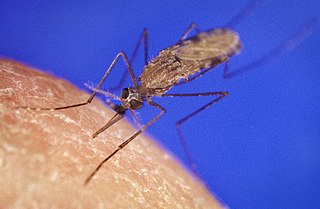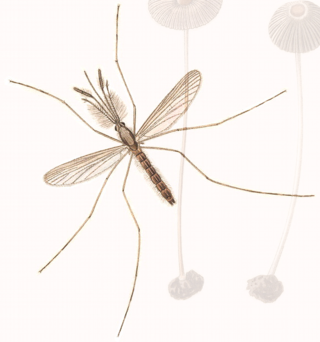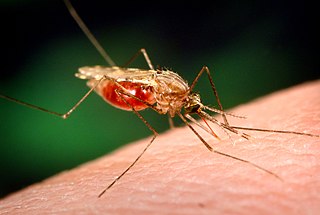
Mosquitoes, the Culicidae, are a family of small flies consisting of 3,600 species. The word mosquito is Spanish and Portuguese for little fly. Mosquitoes have a slender segmented body, one pair of wings, three pairs of long hair-like legs, and specialized, highly elongated, piercing-sucking mouthparts. All mosquitoes drink nectar from flowers; females of some species have in addition adapted to drink blood. Evolutionary biologists view mosquitoes as micropredators, small animals that parasitise larger ones by drinking their blood without immediately killing them. Medical parasitologists view mosquitoes instead as vectors of disease, carrying protozoan parasites or bacterial or viral pathogens from one host to another.

Anopheles is a genus of mosquito first described by J. W. Meigen in 1818, and are known as nail mosquitoes and marsh mosquitoes. Many such mosquitoes are vectors of the parasite Plasmodium, a genus of protozoans that cause malaria in birds, reptiles, and mammals, including humans. The Anopheles gambiae mosquito is the best-known species of marsh mosquito that transmits the Plasmodium falciparum, which is a malarial parasite deadly to human beings; no other mosquito genus is a vector of human malaria.

The Anopheles gambiae complex consists of at least seven morphologically indistinguishable species of mosquitoes in the genus Anopheles. The complex was recognised in the 1960s and includes the most important vectors of malaria in sub-Saharan Africa, particularly of the most dangerous malaria parasite, Plasmodium falciparum. It is one of the most efficient malaria vectors known. The An. gambiae mosquito additionally transmits Wuchereria bancrofti which causes lymphatic filariasis, a symptom of which is elephantiasis.
Avian malaria is a parasitic disease of birds, caused by parasite species belonging to the genera Plasmodium and Hemoproteus. The disease is transmitted by a dipteran vector including mosquitoes in the case of Plasmodium parasites and biting midges for Hemoproteus. The range of symptoms and effects of the parasite on its bird hosts is very wide, from asymptomatic cases to drastic population declines due to the disease, as is the case of the Hawaiian honeycreepers. The diversity of parasites is large, as it is estimated that there are approximately as many parasites as there are species of hosts. As research on human malaria parasites became difficult, Dr. Ross studied avian malaria parasites. Co-speciation and host switching events have contributed to the broad range of hosts that these parasites can infect, causing avian malaria to be a widespread global disease, found everywhere except Antarctica.

Anopheles walkeri is a species of mosquito found predominantly throughout the Mississippi River Valley, with its habitat ranging as far north as southern Quebec, Canada. The eggs of A. walkeri are laid directly on the water surface in freshwater swamp habitats. Since its eggs are not resistant to desiccation, this species is restricted to swampy regions with plenty of water. Anopheles walkeri, as with many other anophelines, begins to become active later in the evening than most other mosquito species in its range. This species becomes especially active late at night when in search of a blood meal. Feeding activity is affected greatly by environmental conditions within its microclimate. Wind, low humidity and cool temperatures, are all negatively correlated with feeding aggression.

Anopheles albimanus is a species of mosquito in the order Diptera. It is found in coastal Central and South America, the Caribbean, and Mexico. It is a generalist species and capable of wide dispersion. A. albimanus is a common malaria vector.

Anopheles stephensi is a primary mosquito vector of malaria in urban India and is included in the same subgenus as Anopheles gambiae, the primary malaria vector in Africa. A. gambiae consists of a complex of morphologically identical species of mosquitoes, along with all other major malaria vectors; however, A. stephensi has not yet been included in any of these complexes. Nevertheless, two races of A. stephensi exist based on differences in egg dimensions and the number of ridges on the eggs; A. s. stephensisensu stricto, the type form, is a competent malaria vector that takes place in urban areas, and A. s. mysorensis, the variety form, exists in rural areas and exhibits considerable zoophilic behaviour, making it a poor malaria vector. However, A. s. mysorensis is a detrimental vector in Iran. An intermediate form also exists in rural communities and peri-urban areas, though its vector status is unknown. About 12% of malaria cases in India are due to A. stephensi.

Anopheles darlingi, the American malaria mosquito, is a species of mosquito in the family Culicidae. A. darlingi is one of the major species of mosquito known to be responsible for malaria in the Amazonian regions. It has a wide range of geographic distribution that stretches from Mexico and Argentina but it has also been found to populate in areas affected by deforestation and environment changes due to humans.

Anopheles claviger is a mosquito species found in Palearctic realm covering Europe, North Africa, northern Arabian Peninsula, and northern Asia. It is responsible for transmitting malaria in some of these regions. The mosquito is made up of a species complex consisting of An. claviger sensu stricto and An. petragnani Del Vecchio. An. petragnani is found only in western Mediterranean region, and is reported to bite only animals; hence, it is not involved in human malaria.

Anopheles sinensis is a species of mosquito that transmits malaria as well as lymphatic filariasis. It is regarded as the most important vector of these human parasitic diseases in Southeast Asia. It is the primary vector of vivax malaria in many regions. In China it also transmits the filalarial parasite, and arthropod roundworm. In Japan it is also a vector of a roundworm Setaria digitata in sheep and goats.
Anopheles nili is a species of mosquito in the Culicidae family. It comprises the following elements: An. carnevalei, An. nili, An. ovengensis and An. somalicus. The scientific name of this species was first published in 1904 by Theobald. It is the main mosquito species found in the south Cameroon forest zone which bites humans. It is known as a problematic carrier of malaria, although newly discovered, closely related species in the same genus have also been found to interact with A. nili as a disease vector. In that, they both have similar feeding habits on local targets in the Cameroon region.
Lutzia fuscana is a mosquito that is predatory in its larval stages. It has been investigated as a possible biological control agent, showing some promise where vector species share limited or specific breeding habitat.

Anopheles barbirostris is a species complex of mosquito belonging to the genus Anopheles. Larvae found in clean, lotic bodies of water. Females are zoophilic, mainly feed blood on cattle and humans. It is also an important vector for Plasmodium falciparum in Sri Lanka and Timor, for both Plasmodium vivax and P. falciparum in Bangladesh.
Anopheles barbumbrosus is a species complex of mosquito belonging to the genus Anopheles. It has 12-36 thin attenuated branches usually loose and separated out, which is a good indication to separate it from A. barbirostris. It shows a marked zoophilic tendency, thus is a malaria vector, but with minor importance to humans. It is distributed throughout Peninsular Malaysia, Sumatra, Java, Thailand, India and Sri Lanka, They mostly live as an outdoor mosquito species, rarely found indoor places. Larva can be found in a variety of habitats including both partially shaded and sunlit fresh and slowly running water, grass-fringed streams to stagnant water pools and man-made places like rice fields.
Anopheles (Cellia) karwari is a species complex of zoophilic mosquito belonging to the genus Anopheles. It is found in India, and Sri Lanka, Bangladesh, Sumatra, and Java. A. karwari is a member of the Maculatus Group and the second scarcest species reported from Indonesia. Female is blood sucking and involved in transmitting Plasmodium falciparum, thus an important malarial vector. It is considered a secondary vector in the Australian region, but its vectorial status in South-East Asia was unknown.
Anopheles (Cellia) tessellatus is a species complex of zoophilic mosquito belonging to the genus Anopheles. It is found in India, and Sri Lanka, Bangladesh, Cambodia, China, Indonesia, Malaysia, Laos, Maldives, Myanmar, Nepal, Philippines, Taiwan, Thailand and Vietnam. It is first described from Sri Lanka. Larvae are known to found from dirty stagnant water in sun or shady habitats. Adults are zoophilic. It is not regarded as a malaria vector, but is a secondary vector of Wuchereria bancrofti in Maldives.
Anopheles (Cellia) vagus is a species complex of zoophilic mosquito belonging to the genus Anopheles. It is found in India, Sri Lanka and Indonesia. It is a potential natural vector of malarial parasite Plasmodium falciparum, and Japanese encephalitis virus. It is highly susceptible to insecticide deltamethrin and resistant to DDT.
Anopheles (Cellia) varuna is a species complex of zoophilic mosquito belonging to the genus Anopheles. It is found in India, Sri Lanka Thailand and Vietnam. It is a secondary malaria vector in Sri Lanka. Larvae are known to feed on detritus, rod and cocci bacteria, diatom, filamentous algae and desmids. A microsporidium Thelohania obscura was discovered from the larvae in India in 1966.

Anopheles freeborni, commonly known as the western malaria mosquito, is a species of mosquito in the family Culicidae. It is typically found in the western United States and Canada. Adults are brown to black, with yellow-brown hairs and gray-brown stripes on the thorax. Their scaly wings have four dark spots, which are less distinct in the male.

Anopheles funestus is a species of mosquito in the Culicidae family. This species was first described in 1900 by Giles. The female is attracted to houses where it seeks out humans in order to feed on their blood, mostly during the night. This mosquito is a major vector of malaria in sub-Saharan Africa.











